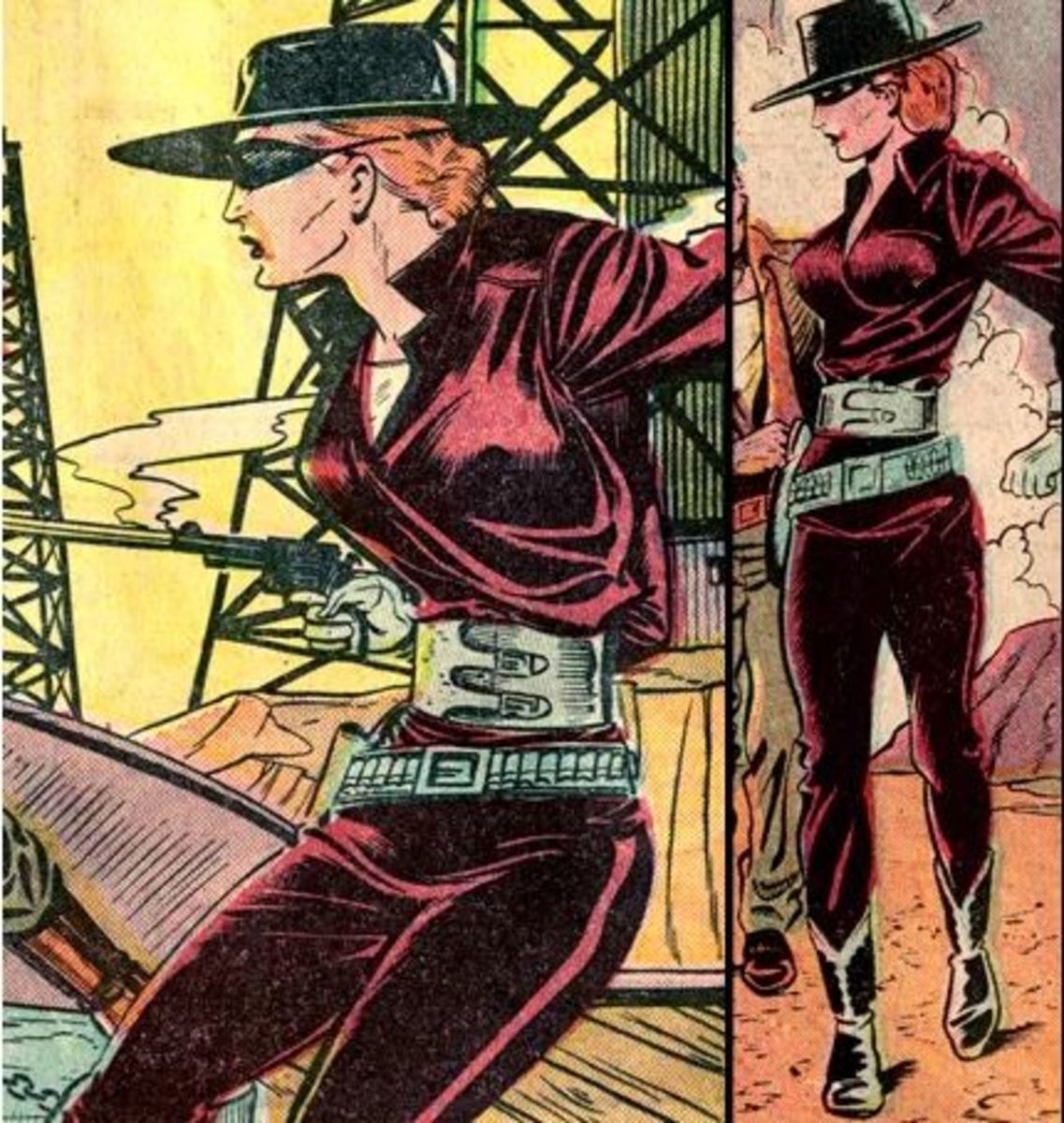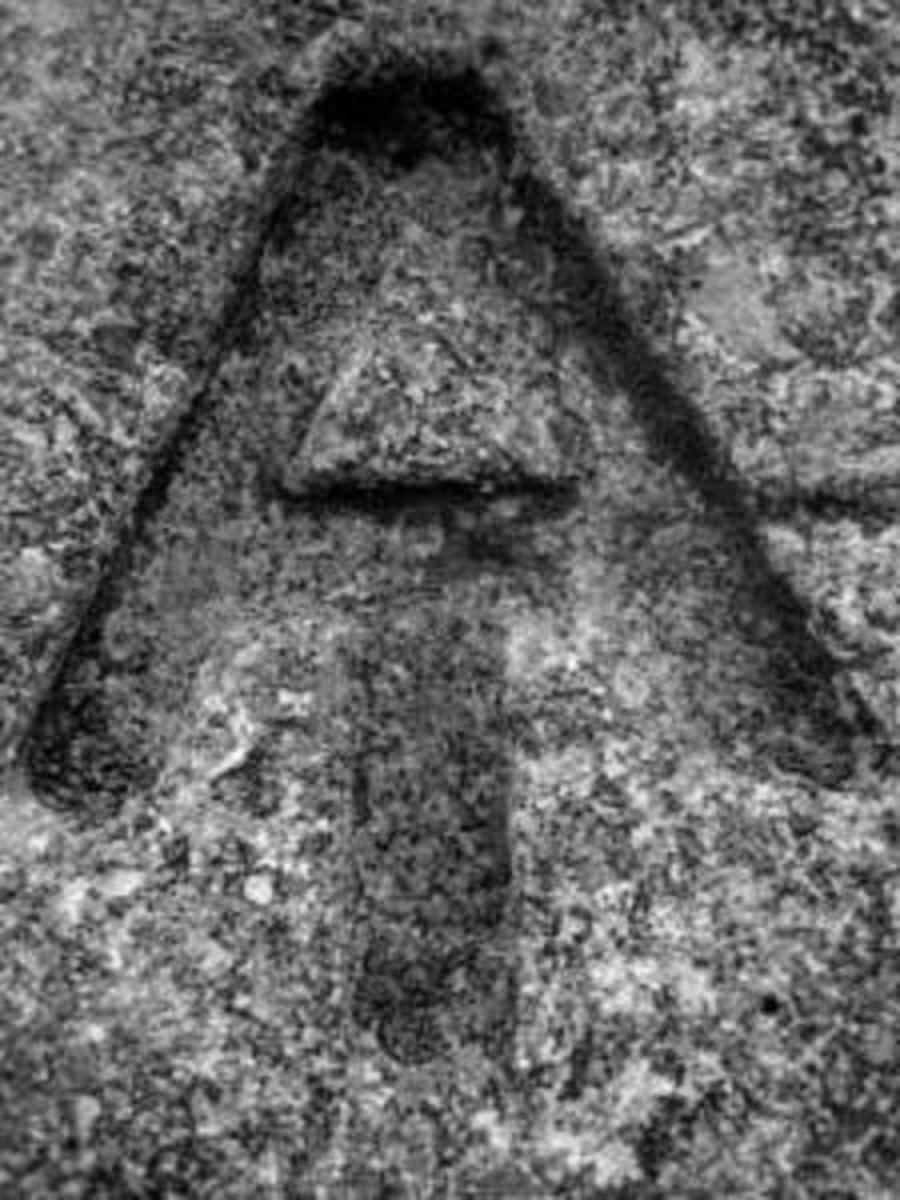Advanced Humanoid Robotics of Science and Sci-Fi Films, TV, and Comic Books
Robot Technology Replicate Human Features
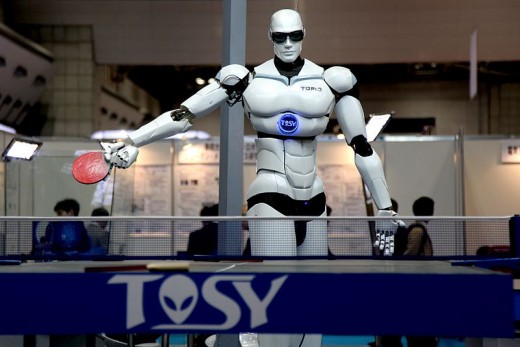
Artistic Human Anatomy
Human-like operating robots began from a simple sketch of a human being. People pose for artists penciling or painting a unique image with variety of materials. Portraiture art generated interest from classical artists. Vincent Van Gogh’s self-portrait achieved memorable attention. The Mona Lisa, Leonardo De Vici's oil painting arouses a sense of mystery behind her smile. Two-dimensional art inspired the creation of three-dimensional artwork leading to the popularity of sculpture.
Famous people throughout history achieved honor by having their resemblance sculptured in dedication to their memory. Donatello, Michelangelo, and Bernini, all classical artists popularized sculpture, and rendered their own version of an Old Testament character, David.
Michelangelo's David
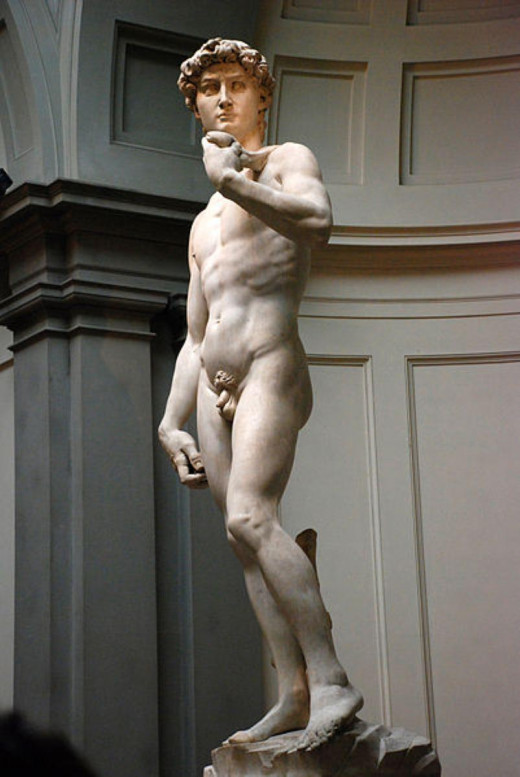
Animating Three-Dimensional Figures
Popular celebrities often appear as wax figures and are exhibited in wax museums. Capture the likeness of human expression influenced creators of artificial intelligence robotics.
Physical movement integrated with human-like robotic figures popularized animatronics. Great Moments with Mr. Lincoln, popular attraction at Disneyland for years, inspired Disney artists to create animatronic attractions such as Pirates of the Caribbean. Haunted House attractions around the world include animatronic figures.
Magical Animated Creatures
Classical mythical beings inspired the creation of human form androids: Prometheus, Pygmalion, the Golem, and Frankenstein monster.
Fantastical Fiction Characters
Character
| Description
| Source
|
|---|---|---|
Prometheus
| The Greek Titan God (forethought), uses clay to create humanity, stole fire from gods, Zeus chains him to rock, and eagle endlessly pecks the titan's liver.
| Greek Mythology
|
Pygmalion
| Sculptor fashions a woman from ivory: Galatea. Aphrodite accepts Pygmalion's prayer; the female ivory statue breathes life.
| Greek and Roman Mythology, Venus a Roman name for Aphrodite
|
Victor Frankenstein
| Scientist creates man from stitched body parts, but unleashes monstrous killer. Chemical generated electricity popularizes galvanism.
| Frankenstein; or the Modern Prometheus Author: Mary Shelly
|
Golem
| A Jewish Folklore inanimate creature magically comes to life. It's name appears in Hebrew Bible, Psalms 139:16 "shapeless mass" or "unfinished substance." Talmudic legend claims Adam lacked a soul the first twelve hours of his creation. The prophet Jeremiah created a Golem.
| Jewish Folklore
|
Three methods of bringing a Golem to life
1. Creator dances around it, utters special letters from a Hebrew alphabet, and God's secret name.
2. The letters aleph, mem, and tav- a letter combination forms the word, emet: "truth" -written on Golem's fo
Sci-Fi Comic Book Robot's Challenge Modern Technology
Early science fiction novelists felt fascinated writing about life-like looking robots. Comic book artists enjoyed drawing them. Early Superman comic books frequently showed the man of steel deploy one of many Superman robots while he played mild-mannered Clark Kent and diverted suspicion away from himself. Early Marvel Comic’s Human Torch was not a human being like Johnny Storm of the Fantastic Four, but a human-like inflamed android. The Japanese developed a comic book about an android robot, Astro Boy, designed to behave with human like intelligence and feelings.
Female Humanoid Robot
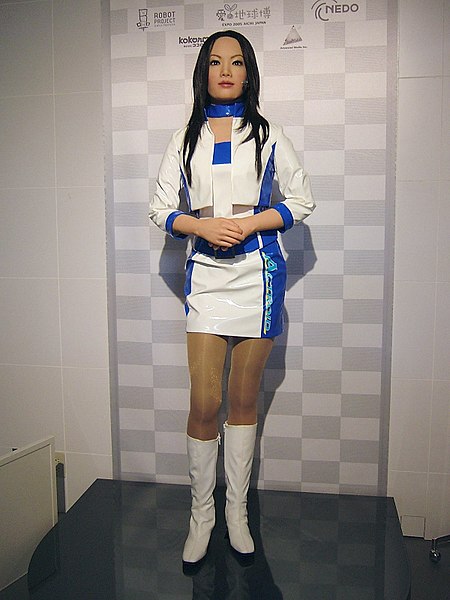
Prosthetic and Bionic Body Parts Surprise Expectations
Physically handicapped people lose arms, legs, or suffer severe mutilation by accidents. Veterans injured at war rely on advanced technology to produce prosthetic body part replacements. Bionic and realistic silicone body parts are available for qualified people. A person suffering eye impairment may choose an artificial eye instead of a black eye-patch. Currently, scientists experiment with bionic eyes that partially restore people’s vision. Prosthetic body parts emulate limbs natural looking as artificial teeth. Luke Skywalker lost an arm during a light saber battle with Darth Vader in The Empire Strikes Back, but after the battle, received a natural looking prosthetic replacement. Such technological development innovates the construction of working robots and human form robots.
Isaac Asimov, a classic science fiction novelist loved to write about robots like, I Robot and Robots of the Dawn. He used the term humaniform robot. Recently, robot creationists achieved great strides; they construct life-like robots carrying on conversations. Humaniform development advances with time.
2018 Realistic Robots
Evil Maria: Inspired Many Future Robotic Films
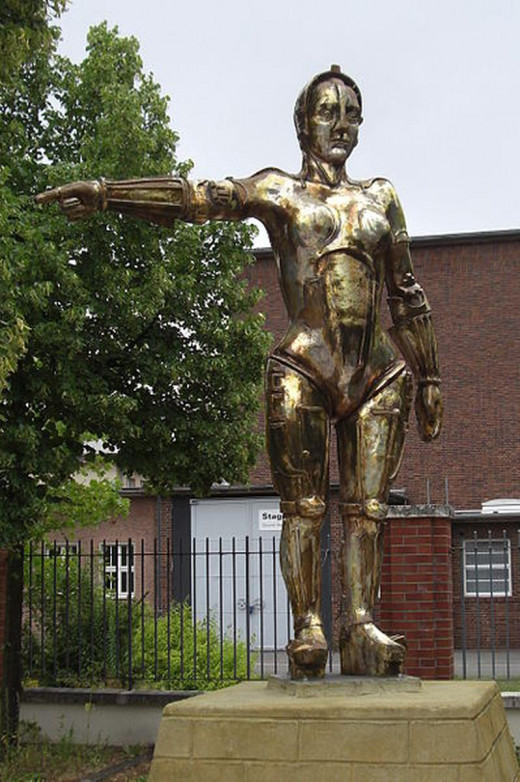
Fritz Lang's Metropolis: Basic Plot
Maria, a young teacher-type, advocate, for mistreated workers, prophesies the coming of a future mediator uniting workers and ruling classes. City master, Fredersen, orders Rotwang, a man with an artificial arm, and robot inventor, to emulate Maria’s likeness into a machine woman, an intention to smear Maria's good name among workers and discourage rebellion. Fredersen becomes duped; Rotwang wants the false Maria to murder his son, Freder, and rule Metropolis. Rotwang abducts Maria, creates her robot look-alike, and delivers it to Fredersen. Freder suffers delirium and hallucinates; he mistakenly thinks Maria embraces his father. Evil Maria shakes-up Metropolis; she incites murderous violence and disharmony among workers.
Freder recuperates, searches the catacombs, faces-off evil Maria, and calls her an impostor. The female robot encourages workers to demolish essential working machines. Fooled workers tag along with evil Maria from the city to machine rooms, and abandon their children. They wreck a Heart Machine that results in city flooding. Authentic Maria sneaks away from Rotwang's house. Freder and Josaphat help her rescue children. Manic depressive workers think the flood kills their children, and seek revenge by burning evil Maria at the stake. Freder realizes deception; he eye-witnesses a fire expose a metallic machine. Rotwang had lost Hel, the name of Feder’s deceased mother to Frederson, and pursues Maria to the cathedral roof. Freder engages him into a life and death battle above street spectators, Fredersen and workers stand in the street. Rotwang plunges to his doom. Freder engages a hand grip union with Fredersen and Grot, (Heart Machine, foreman), which seals his role as mediator.
Robots Featured in TV Series and Film
Title
| Basic Premise
| Director
| Writers
| Stars
|
|---|---|---|---|---|
Westworld (1973 Film)
| Amusement Park androids lose control and murder people.
| Michael Crichon
| Michael Crichon
| Yul Brenner, Richard Benjamin, and James Brolin
|
Westworld (2016 HBO TV series)
| Guest attendants of android wild west them park explore wild imaginings.
| Executivie producer: J.J. Abrams
| Created by Jonathan Nolan and Lisa Joy
| Evan Rachel Wood, Thandie Newton, Jeffrey Wrights, and James Marsden
|
Universal Soldier: Regeneration (2009 Film)
| Luc Deveraux, diseased Vietnam Soldier reanimates into a U. S. government project, a super-powered soldier.
| John Hyams
| Victor Ostrovsky, Richard Rothstein, Christopher Leitch, and Dean Devlin,
| Jean-Van Claude Damme
|
A. I. Artificial Intelligence (2001 Film)
| Ten year-old David, programmed to love, abandons adoptive family and searches for belonging.
| Stephen Spielberg
| Brian Aldis, short story, "Supertoys Last All Summer." Long Screen story: Ian Watson, screenplay: Steven Spielgerg
| Haley Joel Osment, Jude Law, and France O'Connor
|
Bicentennial Man (1999 Film)
| Andrew Martin, a Robot, wants to be human and evolves towards one with many upgrades to his system.
| Christopher Columbus
| Short story: Isaac Asimov Novel: Isaac Asimov and Robert Silverberg Screenplay: Nicolas Kazan
| Robin Williams
|
Star Trek: Generations (1987-1994 TV series)
| Lieutenant Commander, Data, a Soong-type android, created around 2330’s, a first Starfleet officer of his kind.
| Created by Gene Roddenberry
| Gene Roddenberry, Ronald D. Moore, Brannon Braga, and Rick Berman
| Patrick Stewart and Brent Spiner
|
Terminator 2 (1991 Film)
| Skynet Computer sends a powerful android, T-101, to kill John Conner as a child, a future leader fighting against machine men.
| James Cameron
| James Cameron and William Wisher
| Arnold Schwarzenegger, Linda Hamilton, Robert Patrick, and Edward Furlong
|
Terminator 1 (1984 Film) Data-Analyzing Robot Youth Lifeform
| A cyborg assassin attempts to kill the mother of a future machine man resistance leader.
| James Cameron
| James Cameron and Gale Anne Hurd
| Arnold Schwarzenegger, Linda Hamilton, Michael Biehn
|
Robocop (1987 Film)
| Superhuman cyborg enforces law in Detroit, Michigan.
| Paul Verhoeven
| Edward Neumeier and Michael Miner.
| Peter Weller
|
Aliens (1986 Film)
| Lance Bishop, android, built on LX-469, updated Hyperdine model, extraterrestrial life investigator. Colonial Marine Corps member: executive officer: USS Sulaco’s mission to LV-426’s colony. He investigates communication problems.
| Ridley Scott
| Story and Screenplay: Dan O’Bannon
| Sigourney Weaver, Carrie Henn, Michael Biehn, Bill Paxton, and Lance Henrikson
|
D.A.R.Y.L (1985 Film) Data-Analyzing Robot Youth Lifeform
| Government created robot resembles ten-year-old boy. Foster parents don’t know he possesses super reflexes and mental abilities.
| Simon Wincer
| David Ambrose, Alan Scott, and Jeffrey Ellis
| Mary Beth Hurt, Michael McKean, and Kathryn Walker
|
Bladerunner (1982 Film)
| Nexus series of replicants: identical to humans but super-powered. A worn-out policeman pursues fugitive replicants.
| Ridley Scott
| Hampton Fancher and David Peoples Based on Novel by Philip K. Dick, "Do Androids Dream of Electric Sheep?"
| Harrison Ford
|
Stepford Wives (1975 Film)
| Quiet submissive wives are replaced by identical robots.
| Bryan Forbes
| Screenplay: William Goldman Novel 1972, written by Ira Levin
| Katherine Ross and Paula Prentiss
|
(2004 Film)
| Frank Oz
| Paul Rudnick
| Nicole Kidman, Glenn Close, and Bette Midler
| |
The Twilight Zone ( Rod Serling's 1959-1964 TV series) Season 5, Episode 2, "Steel"
| Male boxing fighters are replaced by robots. Battling Maxo breaks down and his owner, replaces him.
| Don Weis
| Richard Matheson (Based on short story "Steel," May 1956 edition, The Magazine of Fantasy and Science Fiction.)
| Lee Marvin
|
Metropolis (1927 silent film)
| Evil female robot fools workers to wreck city machines and flooding endanger children.
| Fritz Lang
| Thea von Harbou wrote the novel and screenplay
| Brigitte Helm, Alfred Abel , Gustav Fröhlich, Rudolf Klein-Rogge
|
Super-powered robots in television and film inspire modern science technology.
Robotic Technology Benefits Humanity
Would you care for a robot replicant modeled from your own human physical features?
Summary
Science fiction stories about advanced technological robots inspire scientists to develop actual working robots and prosthetic body parts. Robotics has long been considered a valuable technological field to solve complex problems. Police investigation, war commanders, and space exploration astronauts, can enable robots to physically enter dangerous situations jeopardizing human safety. Bicentennial Man explored the theme of making a human like robot express feelings typical of man, and aspired towards becoming human. Westworld, the film and television series, warns us about the consequences of failing to keep robots under control; carelessness can unleash “false Maria’s,” the female android of Fritz Lang’s Metropolis. Artificial prosthetic body parts continue to benefit disabled people. People losing natural arms and legs, are still able to run around the track, and utilize artificial hands to clutch objects.
Additional references
https://www.ancient.eu/Prometheus/
https://www.britannica.com/topic/Pygmalion
https://www.pagebypagebooks.com/Mary_Wollstonecraft_Shelley/Frankenstein/
https://www.myjewishlearning.com/article/golem/
idmb.com
wikipedia.com



